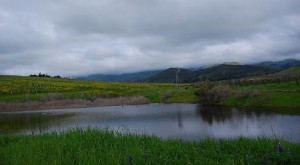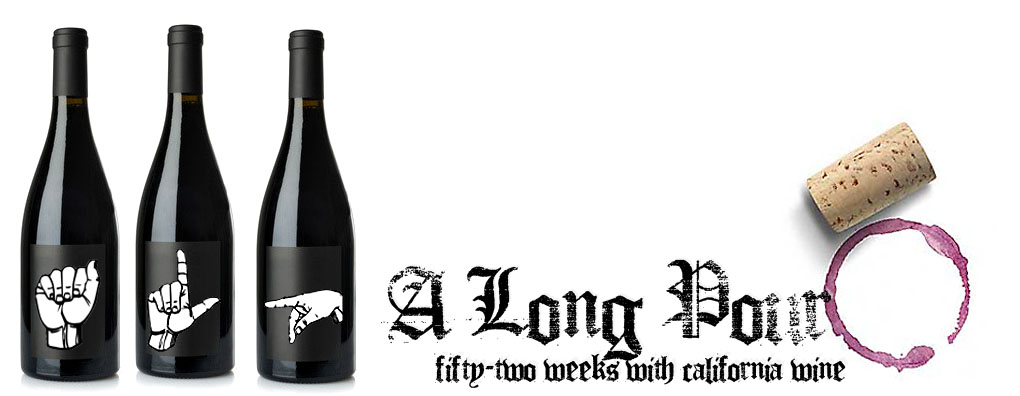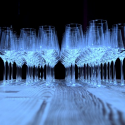Wolff Vineyards, A Study in Sustainability
He once created a world-class wine from a bottle of Welch’s grape juice simply by looking at it; Robert Parker scored it 94 points. He can sign fluently in American Sign Language using only his feet. He once met the Prince of Belgium and sold him wine. For fun, he sometimes blows-up hotdogs using either electrical current or his charming smile. He protects threatened California Pacific Pond Turtles and restores native streams, all while sleepwalking. He won a world championship in water skiing, without skis, or a boat. He started the California Gold Rush. His wine mentor invented a special alloy for NASA and taught him how to break dance. He is the most interesting man in Central Coast wine.
After a little over an hour of conversation, I jokingly told Jean-Pierre last week that he reminded me of those Dos XX commercials. He laughed and said, “Yeah, yeah, that’s me!” While not all the statements above are true or fully accurate, Jean-Pierre, a vintner and owner of Wolff Vineyards in Edna Valley, is a remarkably interesting person. To illustrate my point, the following statements ARE all true.
Jean-Pierre was born in Belgium. He has a B.S. in BSEE (electrical power) with a minor in Nuclear Engineering, an M.B.A. from Pepperdine, and a P.H.D. in Applied Science and Technology). He owned a successful energy testing company. He sits on the UC Davis Advisory Board for the Center of Sustainability and Cal Poly Executive Advisory Board of SARC (The Sustainable Agriculture Resource Consortium), and on the Dean’s Advisory Board of the College of Agriculture, Food and Environmental Science. He was a recent President of the Central Coast Wine Growers Association. He is a special Attaché to the Belgium Government on Technology. He really did meet the Prince of Belgium and had his wine served at the palace in Brussels. He owns a pond designed specifically to protect the threatened California Pacific Pond Turtle, and he has restored the creeks that run through his 125-acre vineyard to encourage Salmon spawning. His wine mentor actually invented a special alloy while working at Rocketdyne, which made the moon landing possible. On top of all of this, Jean-Pierre is immensely charming and well spoken.
 Last Friday, my friend Jordan and I met with Jean-Pierre at his vineyard on the outskirts of San Luis Obispo. A few months ago, I met Jean-Pierre in my professional career, when he came to my office to lecture on arc-flash safety for an electrical testing and engineering firm he consults for. His knowledge of electrical power distribution and theory is impressive and when I learned he owned a winery I made an appointment to visit him.
Last Friday, my friend Jordan and I met with Jean-Pierre at his vineyard on the outskirts of San Luis Obispo. A few months ago, I met Jean-Pierre in my professional career, when he came to my office to lecture on arc-flash safety for an electrical testing and engineering firm he consults for. His knowledge of electrical power distribution and theory is impressive and when I learned he owned a winery I made an appointment to visit him.
The vineyard is spectacular. As we stood in the crisp morning air, we were surrounded in every direction by sweeping views of the Edna Valley, which is incredibly green this time of year. Jean-Pierre pulled up from around the back of the tasting room in his mid-size SUV. After brief hellos, he told us to hop in and off we were for a tour of the property.
Wolff Vineyards, which Jean-Pierre purchased in the late 90’s, has been transformed into a refuge of sorts. As a participant in SIP (Sustainability In Practice), which is managed by the Central Coast Vineyard Team, Wolff Vineyards is farmed to stringent specifications encompassing the entire wine making process. The vineyard is incredibly green, literally. The native cover crop is allowed to stay, leaving the vineyard to look like sea of emerald green pok-a-dotted with yellow wild flowers. In many other vineyards, even ones using terms such as “sustainable” and “green”, wild grass and other native cover crops are sprayed or disked (the process of roto-tilling the ground). However, at Wolff and other vineyards truly using sustainable practices, the cover crop is utilized as a natural way to promote healthy soils and reduce erosion, even as a natural wick to deliver rain water to the soil. Everything at Wolff has a purpose.
We bounced past old rows of Chardonnay, hills of Pinot and Syrah, and past Jean-Pierre’s tur tle pond. The pond was an existing feature of the property when Jean-Pierre acquired it, but he has expanded the size, dug a 40 foot well to serve as a water supply, and planted it to provide a suitable habitat for not only the native California Pacific Pond Turtles, but for native birds as well. On the northern border of the property, a small creek divides Wolff Vineyards from its neighbor’s property. Jean-Pierre stopped the car and we all hopped out. Jordan and I had to move quickly to keep up with Jean-Pierre’s brisk pace. Here, much effort has gone into restoring the creek, including erosion control, re-vegetation, shading, and several bio-engineering alternatives aimed at providing a suitable habitat for spawning salmon.
tle pond. The pond was an existing feature of the property when Jean-Pierre acquired it, but he has expanded the size, dug a 40 foot well to serve as a water supply, and planted it to provide a suitable habitat for not only the native California Pacific Pond Turtles, but for native birds as well. On the northern border of the property, a small creek divides Wolff Vineyards from its neighbor’s property. Jean-Pierre stopped the car and we all hopped out. Jordan and I had to move quickly to keep up with Jean-Pierre’s brisk pace. Here, much effort has gone into restoring the creek, including erosion control, re-vegetation, shading, and several bio-engineering alternatives aimed at providing a suitable habitat for spawning salmon.
The quick pace of the tour and the rapid amount of information Jordan and I were trying to absorb left me wishing I had recorded the entire ride and conversation. It was fascinating to see the length Wolff Vineyards is taking to be a good steward of the land. We ended the tour back at his tasting room, an hour or so before it was to open to the public. Over a tasting of their wines, I was able to ask Jean-Pierre how he got into making wine, what sustainable means to him, and what he enjoys the most about his new career.
How did you go from electrical theory to making wine in Edna Valley?
“When I was 16 years old I wanted to be an agronomist. So I was on track in high school to become an agronomist. Then, for some reason, I switched to nuclear engineering and then electrical power. But, it was still always in the back of my head as something I would like to do. A little over thirty-five years ago I was still “jeez, I would like to do that someday you know.” We all have our dream and our vision, but in life we track something we do, that may not be what we truly want to do, but you can be successful at it despite. Then, as years go by, you get in your comfort zone and you forget about it and you don’t make changes. Or you take the alternative of saying, “nope, I’m still going to do it.” So I fell in that category. But you know, I planned it [making wine] a little bit in advance, not like I got out of bed and [jumped in]. I prepared myself, went to Davis, took viniculture oenology, not for credit, I didn’t want to have another degree.”
What does sustainable mean at Wolff Vineyards?
 “I view sustainability as the three legged stool, you get the three E’s. You have one E: which is the ecological or environmental aspect. That gets into no tilt, no disking, low herbicides, low pesticides, natural habitats, water quality, air quality. I mean to say low herbicide and low pesticide use. That’s one of the E’s. The other E, I point to a portion of it as social equity, and that is how you treat your employees: Are they compensated? Do they get health benefits, transportation, lodging? It’s also how you work with your neighbors, do you tick off your neighbors?…Social Equity is also, how you reach out to your community. I do a lot of tours here and involve the community.”
“I view sustainability as the three legged stool, you get the three E’s. You have one E: which is the ecological or environmental aspect. That gets into no tilt, no disking, low herbicides, low pesticides, natural habitats, water quality, air quality. I mean to say low herbicide and low pesticide use. That’s one of the E’s. The other E, I point to a portion of it as social equity, and that is how you treat your employees: Are they compensated? Do they get health benefits, transportation, lodging? It’s also how you work with your neighbors, do you tick off your neighbors?…Social Equity is also, how you reach out to your community. I do a lot of tours here and involve the community.”
Jean-Pierre went on to explain a little more about the function of his creek and the role it plays for bio-engineering research and development. “I agreed for the creek to be used as a demonstration site. So it will be an interpretative trail for the California Salmon Federation.” When we walked the creek with him earlier, he pointed out some of the areas that had been restored and the techniques used to restore it. Back at the tasting room, he explained what we saw in greater detail. “It is a bunch of bio-engineering techniques,” he told us, “they’re all different. This is the Jay Hook technique, this is the fish bone, this is the willow matt technique, this is the willow trench. It’s like a botanical garden for bio-engineering.”
To Jean-Pierre, the vineyard is not merely a property that produces grapes, it has become a living lab that he can share with others to advance and push the limits of sustainability. “The social equity gets into being a responsible citizen within the community and as a farmer, with outreach, show you are not a bad guy, you are part of the solution not the problem,” he added.
But sustainability runs deeper than treating your neighbors well and being a responsible citizen. The numbers are also important, what does your operation do to minimize or reverse negative effects on the environment? “This is where sustainability is a lot more than just herbicides and pesticides,” he explained. “We all talk about green house gas. Well my vineyard is a perfect example of carbon sequestration, because the cover crops that I have, the grass sequest carbon…A vineyard is a carbon sink…from the cover crop you use and [from] the vine itself. Because, the carbon is trapped into the wood material, in fact 80% of wood is carbon, then all the prunings are chipped into the vineyard and stay in the vineyard. I’m not even carbon neutral, I am carbon negative from the standpoint that I sequest or store more carbon than what I release.”
“The third E is economic sustainability. If you cannot be economically sustainable you are going to succumb to developers. If you can’t make a living at it, you’re going to build houses or the bank will take it back from you. That gets into succession plans, passing on the land for future generations. If you farm sustainably, you’re putting back in as much as you take out. So, the farming operation will still be sustainable in 100 years. So that’s ultimately what sustainability means.”
A few days after our interview, Jean-Pierre and I spoke more in depth about pesticides and he pointed out that “certified organic growers are allowed to use herbicides and pesticides as long as they are approved and labeled organic.” Wolff Vineyards does apply the use of soft and targeted pesticides in-line with the organic guidelines.
Do you have a favorite aspect of winemaking?
“Uh, favorite aspect is…”, Jean-Pierre begins.
Here Jean-Pierre’s son Mark jumps in. “It’s either bottling it or selling it”. We all laugh. Mark continues, “The reason for him liking bottling, it’s because its safe, it’s sound, you’re done. Everything you’ve done is kind of complete, it’s packaged, ready to go.”
“You know,” Jean-Pierre adds, “overall, it’s the bottling. Bottling is your very last opportunity to screw things up. Up to the very last bottle: “oh jeez, I ran out of labels, ran out of cork.’ Or, ‘man we don’t have enough glass.’ So, you see, sometimes a Syrah in a Chard glass. And why do you think? Because, they ran out of glass. So that’s when my babies are safe, sound. That’s kind of, you know, the ultimate. I think Mark, repeats what I say, bottling and selling it. The selling part is meeting my third E, economic sustainability. But also, the tasting room is my fruit stand. You go to a fruit stand and buy fresh strawberries. I take the fruit and I sell you fermented juice from my fruit.”
You have inspired many in wine and other fields, who has inspired you?
“My mentor, which was “Meo”(Romeo Zuech, owner and winemaker of Piedra Creek who owned the property prior to Jean-Pierre), the fellow from Rocketdyne … who taught me the rudimentary of winemaking. He is one who has inspired me. I looked a little bit at Talley and their model, being family owned. And then many many years ago there was Benzinger, oddly enough which is in bio-dynamics. I looked at what they were doing, and I’m talking fifteen, twenty years ago. And saw some of their efforts in the organic biodynamic side.”
There was one more inspiration Jean-Pierre wrote to me about several days after our interview. “I cannot leave the article without giving credits to my wife Elke,” he wrote me. “She has been very supportive of this family venture and an active participant. With her CPA background, she keeps my optimism under check.”
The efforts Wolff Vineyards is taking go above and beyond most wineries. But, as Jordan and I took a final drive through the property on our way out of town, past the turtle pond, past the flocks of birds, you couldn’t help but marvel in the beauty of the place. This is what sustainability should look like. Wolff Vineyards isn’t simply a winery, but a living laboratory for environmental advancement. What he is creating is a testament to what can be achieved with a little knowledge, time, and a lot of heart.
Wolff Vineyards provides fruit to some of the most respected wineries in California as well as produces their own estate Chardonnay, Riesling, Pinot Noir (I highly recommend), Syrah, Petite Sirah, and Teroldego
6238 Orcutt Road
San Luis Obispo, California 93401
Open daily 11am to 5pm
(805) 781-0448



[…] Read the rest here: A Long Pour {Fifty-Two Weeks With California Wine} » Blog Archive … […]
[…] tour at the Paso Robles winery. Sitting on 120 acres, the landscape was drastically different than Wolff Vineyards in the Edna Valley we had left a few hours earlier. The management styles of the two vineyards […]
[…] This was the second day of my recent wine tasting trip with my friend Jordan. Having interviewed Wolff Vineyards and Tablas Creek the day before, and having just left a tasting in the members area and barrel room […]
[…] was Jean-Pierre Wolff, another Ph.D. making wine in Edna Valley, who I profiled a few weeks earlier that encouraged me to […]
[…] While a few stand out to me as exceptional pieces of land (Star Lane’s Happy Canyon vineyard, Jean-Pierre’s Wolff Vineyard), Jordan’s vineyard outside Healdsburg, is an absolute marvel. The property sits on 1,300 […]
[…] and environmentally helpful practices in place at Wolff Vineyards, check out Wayne Kelterer’s story and interview with Jean-Pierre, which delves much deeper than I was able to into this fascinating […]